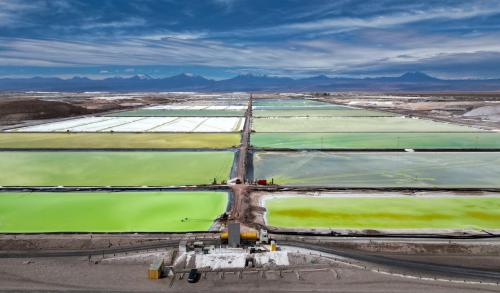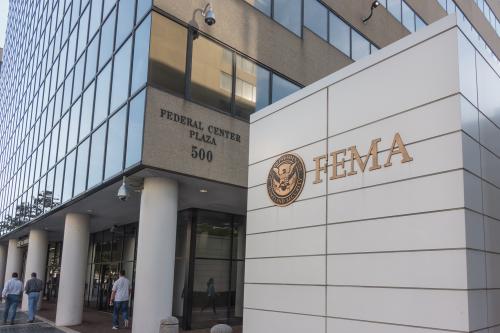INTRODUCTION
On April 9-10, 2009, the All India Disaster Mitigation Institute (AIDMI)[1] and The Brookings-Bern Project on Internal Displacement[2] co-convened a two-day workshop on “Protecting and Promoting Rights in Natural Disasters in South Asia: Prevention and Response” in Chennai, India. A total of 37 participants attended from Bangladesh, India, Maldives, Myanmar, Nepal, Pakistan, Sri Lanka, and the United States. Participants represented national and international non-governmental organizations (NGOs), the International Committee of the Red Cross (ICRC), civil society organizations, the UN, government representatives, the military, media, academic institutions and environmental organizations. The workshop brought together diverse policymakers, activists and practitioners to discuss the salient issues related to protecting and promoting human rights in South Asian disasters.
The objectives of the workshop were:
- To introduce and raise awareness of the Inter-Agency Standing Committee’s (IASC) Operational Guidelines on Human Rights and Natural Disasters;
- To discuss the added value of a rights-based approach to humanitarian response in natural disasters with an emphasis on the national and regional context;
- To discuss good practices in terms of regional, national and local monitoring mechanisms of humanitarian response in natural disasters;
- To generate specific recommendations to strengthen policy and action for rights protection at the local, national and regional levels.
Background
South Asia is a “theater for disaster.” In the past decade alone, floods, cyclones, earthquakes, droughts, and a devastating tsunami destroyed hundreds of thousands of lives and livelihoods and left millions more homeless. In each disaster, humanitarian responders rushed to the scene to preserve human life and reduce immediate suffering.
For many humanitarian agencies involved in immediate disaster response, human rights protection has been a secondary concern. It is the national government that is charged with the responsibility to protect the rights of its citizens–including when citizens are displaced. When governments are unable or unwilling to act, or require assistance, humanitarian actors must step in to fill this “protection gap.”
This workshop was organized with the aim of discussing The IASC Operational Guidelines on Human Rights and Natural Disasters[3], the practical guide to fill this gap. The Operational Guidelines, published by the Brookings-Bern Project on Internal Displacement, were formally adopted by the Inter-Agency Standing Committee in June 2006 and include a list of easily accessible principles and guidelines for humanitarian actors to promote a human rights based approach in disaster response and relief. The accompanying Field Manual (currently under revision) explains the human rights legislation that undergirds the guidelines and outlines how they can best be implemented in the field.
Regional Context
This workshop was organized to develop a concrete strategy for rights promotion in South Asian disasters. All too often, egregious human rights abuses have been committed, either intentionally or unintentionally, in disaster response in South Asia. These abuses came to light most recently in the Koshi River flood in 2008 in Bihar, India, and Nepal; in the 2005 Kashmir earthquake in India and Pakistan; and in the 2004 tsunami that wreaked havoc across the region.
While disaster-affected persons of all groups have suffered rights abuses, monitoring and evaluation continually reveal the exclusion and abuse of particular groups, including women, children, persons from the so-called “lower-castes,” indigenous peoples, older persons, persons with disabilities (PWDs), persons living with HIV/AIDS, and others. Owing to the regional, national, and local contexts, these groups are more vulnerable to rights abuses and it is thus essential to design policies that protect their rights before, during, and after disasters.
National Context
This workshop brought together key practitioners and policymakers working at the national level who are engaged in promoting human rights in disaster response. In India, especially during the tsunami, post-disaster evaluations found many rights violations of marginalized groups. Women, Dalits, indigenous peoples, minorities, children, PWDs, and other groups are often given short shrift when it comes to protection of their rights. In relief, disproportionate aid is frequently disbursed to relatively advantaged groups while Dalits and indigenous minorities are completely neglected. Moreover, international and national humanitarian responders are often unaware of the specific needs of PWDs (such as assistive devices), women (such as feminine hygiene items, undergarments, and, critically, reproductive health care), Dalits, and indigenous groups (such as appropriate food and shelter).
The National Disaster Management Authority (NDMA) of India has taken important steps towards improving human rights protection of marginalized groups in disaster. NDMA is engaged in conversations with human rights advocates at Action Aid India and with others to craft more inclusive and appropriate strategies for rights protection.
[1] Established in 1989 after repeated droughts in India, the All India Disaster Mitigation Institute (AIDMI), Gujarat, is a community-based action research, action planning and action advocacy organization. It works towards bridging the gap among policy, practice, and research related to disaster risk mitigation, in an effort to link the local community with policy level activities. AIDMI sets agendas, shapes knowledge, and pilots projects in favor of the poor and excluded among disaster victims and the vulnerable.
[2] The Brookings Institution-University of Bern Project on Internal Displacement was created to promote a more effective national, regional, and international response to the global problem of internal displacement and to support the work of the Representative of the UN Secretary-General on the Human Rights of Internally Displaced Persons in carrying out the responsibilities of the mandate. The Project monitors displacement problems worldwide, promotes the dissemination and application of the Guiding Principles on Internal Displacement, works with governments, regional bodies, international organizations and civil society to create more effective policies and institutional arrangements for IDPs, convenes international seminars on internal displacement, and publishes major studies, articles and reports.
[3] Available at: https://www.brookings.edu/projects/idp/2006_naturaldisasters.aspx.


